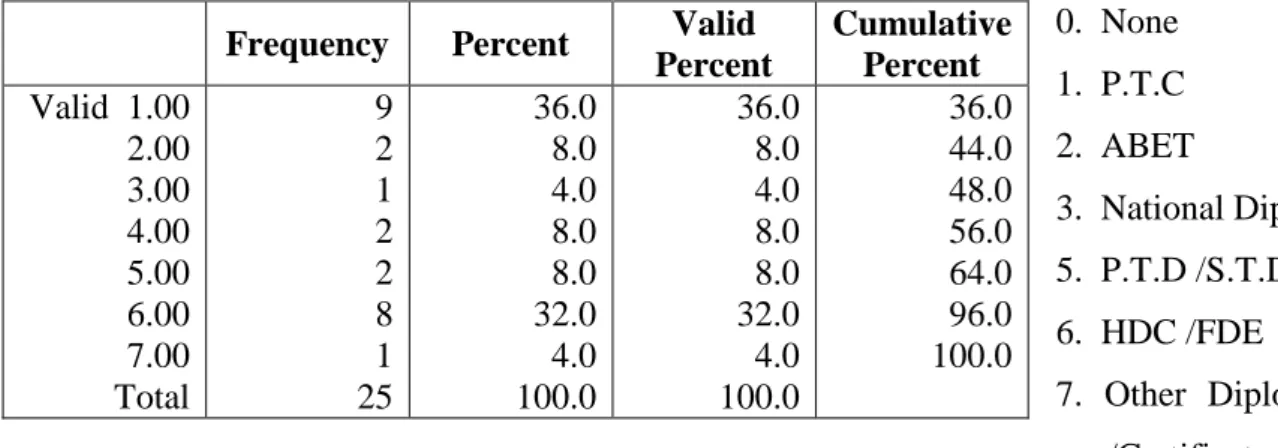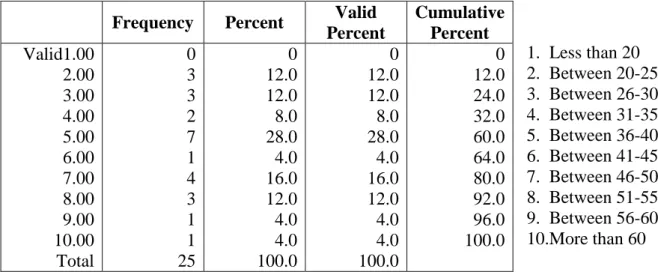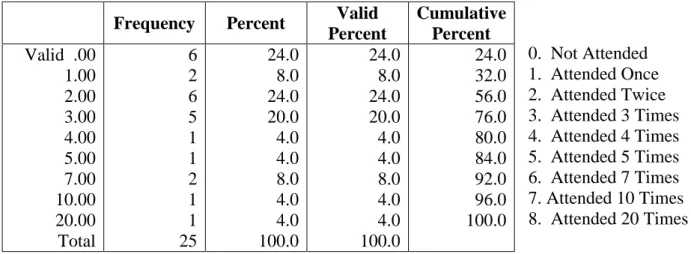It is clear that learners need order in the classroom if the activities that take place are to facilitate effective learning. Further research needs to be done on disruptive behavior in the classroom to provide an overview of the problem.
CAUSES OF MISBEHAVIOUR [DISCIPLINARY PROBLEMS] 10
RELATION BETWEEN DISCIPLINE AND ACADEMIC
VALIDITY AND RELIABILITY OF THE QUESTIONNAIRE 17
FINDINGS FROM THE EMPIRICAL RESEARCH 42
INTRODUCTION
ANALYSIS OF A PROBLEM
STATEMENT OF THE PROBLEM
DEFINITION OF CONCEPTS
- Academic
- Achievement
- Discipline
- Effectiveness
- Performance
- School
- Secondary School
According to Hornby, performance is the act or process of performing a task or an action. This is a formal institution that prepares students for tertiary education or to move into an industrial atmosphere (Piet & Mahlangu, 1990: 57).
METHOD OF RESEARCH
A self-structured questionnaire will be distributed to secondary schools of Ndwedwe District in Ilembe District (eThekwini Region) to be completed by teachers. The questions will be related to the influence of discipline on the academic performance of students in secondary schools.
AIM OF THE RESEARCH
FURTHER COURSE OF THE STUDY
INTRODUCTION
PURPOSE OF DISCIPLINE
According to Khoza (2001:1), schools should be supported to be safe havens where education and learning can flourish. She also argues that parents and students have created a new pattern largely of their own accord, as students can now enroll in schools that are better equipped, more orderly, and achieve better academic results.
CHARACTERISTICS OF EFFECTIVE DISCIPLINE
Equitable protection of the respective interests of the various participants and interested parties within the education system is essential. The purpose of education is to prepare the learner for integration and development in a mature working society.
CHARACTERISTICS OF POOR DISCIPLINE
Obedience: A well-disciplined student obeys every time, even when he argues, he argues in a very positive way. Full participation: A student who participates maximally in school activities has self-discipline and self-respect. Harmony: Discipline plays a vital role in creating harmony among the students in the school.
Courtesy: Even in times of emotional disturbance there is the element of being polite in a well-disciplined student. Being under the influence of drugs or alcohol at school or while participating in school activities.
CAUSES OF MISBEHAVIOUR [DISCIPLINARY PROBLEMS]
RELATION BETWEEN DISCIPLINE AND ACADEMIC ACHIEVEMENT
If there is self-discipline, there are more chances to get direction in the fulfillment of the students. If discipline [effective] is present at school and the parents at home are also aware of good discipline at school and it is also applied at home, this is a good recipe for good academic performance because what is applied at school is also applied in the home. If the school is well facilitated and the students' needs are met, there will be good academic results.
It can also be improved by the availability of resources, relevant educators, enough learning space when guided, relevant teaching style and clear code of conduct. The availability of the above therefore creates good discipline and the school's self-esteem is good. However, if the family background is not good, different social classes are present, the school is located in a socially disadvantaged area and there is a bad influence of peer groups, this will have a negative effect on discipline, so academic performance will also be negatively affected.
This is also the opinion of Charlton and David (1993:32) when they say that if there is not a proper family environment social differences and students come from disadvantaged social areas, this can lead to poor discipline and negative results academically .
SUMMARY
Willis and Williams (1982:4) state that discipline involves all stakeholders and programs as well as personality and school climate. Examples of bad discipline should also be mentioned so that students do not try to try such unacceptable behavior. Educators should be aware of the causes of misbehavior so that in their countermeasures they should know exactly which ones are relevant.
Students should be aware of the relationship between discipline and academic performance and also be aware that effective discipline results in good academic performance.
INTRODUCTION
SELECTION OF RESPONDENTS
RESEARCH INSTRUMENT
- The questionnaire as a research instrument
- Construction of a questionnaire
- Characteristics of a good questionnaire
- Advantages and disadvantages of a questionnaire
They also argue that wording should be clear, that duplicate questions should be avoided, that questions should be relevant, that short, simple items are best, that negative terms, biased items or terms should be avoided. Mahlangu (1987:79) and McMillan and Schumacher mention different types of questionnaires as follows: open-ended questionnaires and closed-ended questionnaires where the respondent is expected to suggest his opinion and the latter has to choose from the given ones. Likert scale type was used in formulating closed questions to collect data from the respondents in three ways: agree, disagree and unsure.
Tuckman also points to the Likert scale as one of the popular ways to apply it in obtaining research data. It is easy to construct a questionnaire even for the amateur investigator and it can be abused. The ability of the respondent to provide information will affect the validity of the results.
Respondents may have little interest in a particular issue and therefore may answer questionnaires indiscriminately.
VALIDITY AND RELIABILITY OF THE QUESTIONNAIRE
Validity
Reliability
PILOT STUDY
ADMINISTRATION OF THE QUESTIONNAIRE
PROCESSING OF THE DATA
Descriptive statistics
Analysis of data
Section four builds on the causes of disruptive behavior that emerged in chapter one.
LIMITATIONS OF THE INVESTIGATION
SUMMARY
INTRODUCTION
DESCRIPTIVE STATISTICS
- Gender of respondents
- Age of respondents
- Academic qualifications of the respondents
- Professional qualifications of the respondents
- Total number of years in teaching profession
- Post level of respondents
- Type of post held by the respondents
- Area of school
- Average number of learners taught per class
- Number of workshops
- Code of conduct
- Purpose of effective discipline in schools
- Rules for effective discipline in schools
- Causes for disruptive behaviour
The majority of respondents (92%) in the research sample agreed that effective discipline is essential for students to show the necessary respect to educators. The majority of respondents (96%) agreed that effective school discipline is essential for an atmosphere conducive to learning. The majority of respondents (96%) agreed that effective discipline is necessary to achieve educational goals.
Most of the respondents (88%) agreed that there must be self-discipline for effective academic performance. More than ninety percent (96%) of the respondents agreed that the learners must have self-control to achieve academically. More than eighty percent (84%) of the respondents agreed with a need for social conformity for effective discipline.
Most respondents (92%) agree that obedience to authority is necessary for effective discipline. The majority of respondents (96%) said that the rules should be clear and concise. More than ninety percent (96%) of respondents agreed that the rules should be displayed in every classroom.

SUMMARY
Sixty percent (60%) of the respondents in this research sample agree that inadequate punishment rules for offenses cause disruptive behavior. The most effective way to combat disruptive behavior is to show students that such incidents will not be tolerated and that appropriate punishments will be used (Van den Aardweg & Van den Aardweg, 1990:188). The majority of respondents (60%) indicated that failure to implement the disciplinary rules in the code of conduct causes disruptive behavior.
The findings suggest that appropriate disciplinary rules should be included in the code of conduct. Mwamwenda states that in some schools only the principal can carry out some disciplinary measures, but the principal is only one person with limited time and it is unrealistic to expect him to deal with all disciplinary problems in the school alone.
INTRODUCTION
SUMMARY
- Statement of a problem
- Literacy review on effect of discipline an academic achievement in secondary schools
- Research design
- Presentation and analysis of research data
- Aim of the study
A code of conduct for students prescribes exactly how they should behave in order to establish the fulfillment of the school's expectations. 84 of 1996 requires the governing body of a public school to adopt a code of conduct for students. The law contains guidelines that the members of the governing body must take into account when drawing up a code of conduct for students.
The main aim of the code of conduct is to create a well organized and supportive school so that effective learning and teaching can take place. The rules and regulations in the student code of conduct should promote self-discipline, encourage good behavior and regulate behavior. An explanation and description of the methods used in the categorization of responses and data analysis was given at the beginning.
This was done in order to clarify the presentation of the data in that it shows the percentage of the total number of cases that were observed for a certain question.
FINDINGS FROM THE EMPIRICAL RESEARCH
More than eighty percent (84%) agreed that punishments for misconduct should be consistent and most affirmed that educators should not overlook unacceptable behavior (see 4.2.13.6). Eighty-four percent (84%) of respondents agreed that students' internalization of self-discipline depends on effective school discipline. The majority of respondents indicated that a conducive atmosphere can only be created if effective discipline is applied at school (see 4.2.13.10).
More than seventy percent (76%) of the respondents agree with the implementation of different disciplines (cf. 4.2.14.2). Sixty percent (60%) of the respondents also agreed that there are insufficient punishment rules in schools. Sixty percent (60%) of the respondents also agreed that there are insufficient punishment rules in schools.
Sixty percent (60%) of respondents agreed that discipline rules should be displayed in every classroom (see 4.2.14.9).
RECOMMENDATIONS .1 Inculcation of good behaviour
Code of conduct for learners (1) Motivation
The common factor is a tendency to produce conditions in which class discipline proves ineffective, so that learning becomes difficult or impossible for the class as a whole. An effectively enforced code of conduct for learners is essential for maintaining effective discipline in a school. A code of conduct for learners is like a compass that shows the school in which direction it is moving.
A code of conduct deals with all matters that may have an impact on the quality of the education. A school cannot operate successfully without a code of conduct, as students will not know how to deal with disruptive behavior or the appropriate punishment for wrongdoing. Without a directive on a code of conduct, the school will function on a baseless basis, and the educational goals cannot be sufficiently realized.
That the district offices of the Department of Education should ensure that all schools have a code of conduct for students.
Further research
CRITICISM
FINAL REMARK
Emmer E, Sanford C & Warsham M (1984) Classroom management for secondary school teachers. 2004) Inclusive Education in Action in South Africa. Everard K B & Morris G, (1996) Effective school management. 1995) Children with emotional and behavioral problems: strategies for assessment and intervention. Van der Aardweg, FM & Van den Aardweg, ED (1988) Dictionary of Empirical Education:. 2003) Educator's guide to school management skills, Pretoria: Van Schaik.








